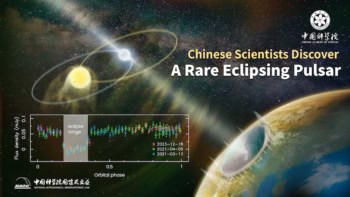
Researchers have, for the first time, used data from flashing neutron stars to constrain what form of matter these dense objects, known as pulsars, might take. Although what we call neutron stars are made mainly of neutrons, mystery surrounds the true nature of the matter contained deep within them.
But in an upcoming paper in Physical Review Letters, Mark Alford and Kai Schwenzer of Washington University in the US say that the trick is to use data from millisecond pulsars.
Previous studies of the interior of neutron stars relied on pulsars’ precursors – low-mass X-ray binaries (LMXBs). LMXBs exist in binary systems, accreting matter from their companion star until the partner gets entirely eaten up to create a pulsar spinning incredibly fast – once every millisecond or so. Unfortunately, LMXBs can only provide limited information about what kind of matter exists inside neutron stars.
Core matter
All known matter is made of quarks and is held together – or “confined” – by strong interactions in the form of hadrons. The matter in neutron stars, however, could well be more exotic, because the physical conditions are so extreme – they have the strongest known magnetic fields and only black holes are denser. Indeed, their density is so high that the interactions between quarks could become weak, allowing the quarks to separate, or become “deconfined”. This could result in a form of matter called “quark matter” that is different to anything we have ever observed.
Researchers have, in the past, looked at LMXB data to rule in or out possible forms of matter that neutron stars might take, but LMXBs are messy systems and the rate at which they spin tells us little about their interior. “All the increasing spin rate of a LMXB tells you is how much it ate that morning from its companion,” says Alford. It is therefore hard to tell if the properties being measured relate to the composition of the star or how it interacts with its companion. Another drawback of using LMXBs is that we have very limited data from just a few dozen LMXBs.
Millisecond pulsars, in contrast, are extremely well-defined systems, rotating at frequencies so precise that they rival atomic clocks. Another bonus is that data exist for hundreds of them. However, millisecond pulsars have a problem of their own, in that we know nothing about their temperatures, a measure that researchers previously relied on to figure out what neutron stars are made of.
New equations
What Alford and Schwenzer have done is to find a way to connect previously existing data from millisecond pulsars to the stars’ interior properties – without having to use temperature measurements. Instead the researchers use the rate at which the spinning of the pulsars gradually slows as they emit energy in the form of electromagnetic and perhaps even gravitational waves.
This let the researchers exploit the large and accurate database of millisecond-pulsar timing data to better discriminate between different possible ideas for what the matter inside neutron stars is really like.
To demonstrate the new method, Alford and Schwenzer confirmed with more confidence than previous methods that the crust of confined hadron matter that we know pulsars have could contain a core of unconfined, interacting quark matter. “It is interesting that the considered form of quark matter is compatible with the pulsar data,” says Schwenzer, “but compact stars are complicated objects, and more work is required to understand what they are made of.”
A word of caution
A key part of the new method involves relating the decline in spin rate of millisecond pulsars to the amount of damping that occurs in the pulsars because of global oscillations. Known as “r-modes”, this damping is linked to the viscosity of the interior matter, which means that possible details of the matter itself can be worked out.
However, Werner Becker, managing director of the International Max-Planck Research School on Astrophysics at the University of Munich, Germany, who was not involved with the work, takes issue with the method’s reliance on the existence of r-modes in neutron stars. “This existence is not experimentally proven at all and is mostly a ‘possible’ scenario,” he says.



